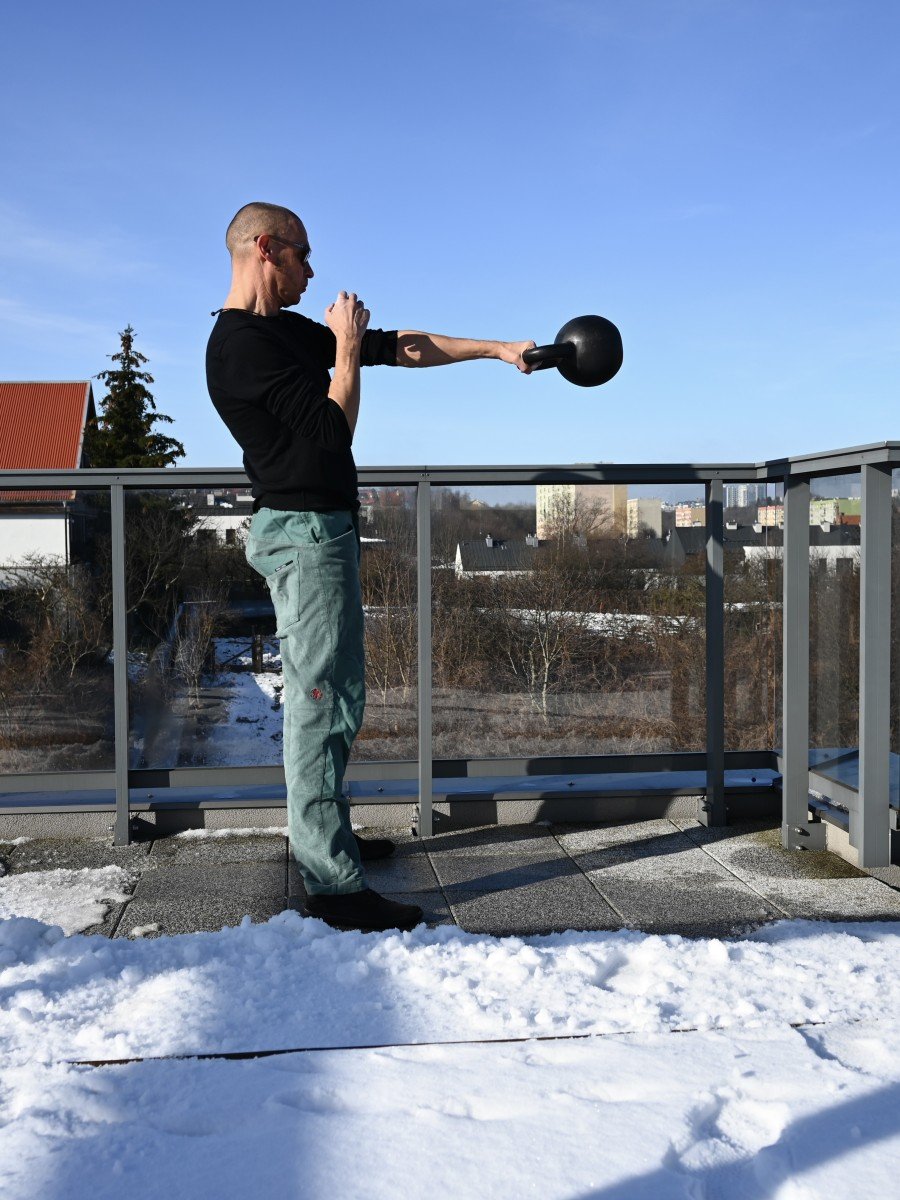The Kettlebell Swing
Many of our patients want and need exercises for different reasons. It's not only to train the muscles or get hypertrophy effects. Related to whats your typical patient in your clinic, your typical exercises could have different aims / targets. An exercise like e.g. the squat, is of course forcing the muscles to work. Factors like the additional weight, the number of repetitions & sets, the rest between the sets and the speed of performing the reps will influence the effect in the muscles and in the vascular system.
However, there are many other effects. During muscle contractions the so called myokines (the function of these myokines are not completely understood yet, but it looks like that they play an important role for immunological reactions, metabolic processes and in many more physiological actions) are expressed by the muscle cells. Passive structures like bones, cartilage, ligaments & tendons are getting stronger with an appropriate stimulation. The vascular cardio system needs to be trained as well. Movement in general, exercises in special, are the drivers of these necessary stimulations and the following positive adaptions.
When it comes to fear avoidance in patients after lumbar surgery or during chronic low back pain e. g., a slowly progressive loading could bring them back to normal activity.
And here comes the classic hard style kettlebell swing as an amazing useful skill or drill. Imagine a patient who is afraid to bend down to keep up an apple from the floor, will swing in an explosive way a 12, 16, 24kg or even a heavier kettlebell in an explosive way. Yes, it's possible, with many many positive effects.
On the first glance it looks like a shoulder exercise, but almost all force is generated by a fast contraction of the posterior chain (glutes, hamstrings). A strong abdominal contraction will avoid hyperlordosis in the lumbar spine. If you perform a one arm swing, the abdominal obliques and contralateral glutes have to work more. Grip strength will develop quickly.
How to perform a safe and efficient kettlebell swing: please check the YouTube channel from Louka Kurcer (Hardstyle Kettlebell Pro), there you'll find an excellent video how to perform the kettlebell swing.
As a physio, specialised in the management of patients presenting with neuromuscular skeletal problems, I’m using passive techniques, explanations, ergonomic changes and of course exercises. In the mid '90s, when “heavy weights” weren’t a standard tool in an ordinary physio clinic; btw: I was taught at my physio school, that any compressive force will harm the disc....), I did deadlifts e. g. with many of my LBP patients. In 2020 during the covid pandemic I got in contact with kettlebells. And I’m more than impressed. Many many benefits. It’s like a minimalistic gym for our patients when they want to perform their exercises at home. No big money investment and almost no space for storage.
Some effects / mechanisms of the kettlebell swing are shown by research:
McGill et al (2012) found in their EMG study, that the glutes and the back extensors muscles are acting in a rapid way during the swing. They found also, that swing is not producing a huge compression force, however, they observed a posterior shear force of L4 on L5.
Jay et al (2011) investigated the effect of an 8 weeks Kettlebell training (including the swing) on 40 workers who reported about musculoskeletal pain. Compared to the control group, the Kettlebell group showed significantly decreased cervical, shoulder and lumbar pain as well as an increased strength in the trunk extensor muscles. No difference between the groups in the aerobic capacity.
An interesting study has been done by Meigh et al (2022). They examined the effect of a 3 months “hardstyle” kettlebell program in a group of insufficiently active 32 subjects in older age (59-79 years). Outcome measurements like grip strength and other health related parameters increased. There were only 4 non serious adverse events during the time.
Chen et al 2018 examined the effect of an 8 weeks (2 times per week) long kettlebell training (inclusive the swing) program for 33 women in the age between 65 - 75 years with confirmed sarcopenia. They observed an increase in grip strength, an increase in the sarcopenia index and more back strength. The effect was still 4 weeks after finishing the training there. A stronger grip strength is associated with a stronger upper limb strength and global upper limb function (Martins et al 2015).
Three typical clinical applications:
Patients with a functional lumbar instability, (motor control impairment) with a give in extension, could benefit a lot from a double arm kettlebell swing training.
Golfers with low back pain due to a give in extension / rotation would rather benefit from a sigle arm swing training.
Patients with knee pain and a fear of squatting don't realise during the classical swing with a so called hip hinge squat, that they use also knee flexion up to 70 degrees (McGill et al 2012). One could even modify the swing in both directions, either more ore less knee flexion.
When I got in contact with the kettlebell, it was just fun and excitement. And it is still today. Since around 2,5 years I'm using the kettlebell as one of the favourite tools with my patients when it comes to exercising. Especially patients with chronic LBP getting pretty much surprised when they are able to perform an explosive kettlebell swing. Of course this doesn't appear in the first session. It needs a lot of good explanations and sometimes other exercises to make the patients believing to their own back again, This makes my job still (after more than 30 years in the business) interesting and curious.
Literature:
Andersen, Vidar, Marius S. Fimland, Aril Gunnarskog, Georg-Andrè Jungård, Roy-Andrè Slåttland, Øyvind F. Vraalsen, and Atle H. Saeterbakken. ‘Core Muscle Activation in One-Armed and Two-Armed Kettlebell Swing’. Journal of Strength and Conditioning Research 30, no. 5 (May 2016): 1196–1204.
Chen, Hung-Ting, Huey-June Wu, Yu-Jen Chen, Sung-Yen Ho, and Yu-Chun Chung. ‘Effects of 8-Week Kettlebell Training on Body Composition, Muscle Strength, Pulmonary Function, and Chronic Low-Grade Inflammation in Elderly Women with Sarcopenia’. Experimental Gerontology 112 (October 2018): 112–18.
Falatic, J. Asher, Peggy A. Plato, Christopher Holder, Daryl Finch, Kyungmo Han, and Craig J. Cisar. ‘Effects of Kettlebell Training on Aerobic Capacity’. Journal of Strength and Conditioning Research 29, no. 7 (July 2015): 1943–47.
Jay, Kenneth, Markus D Jakobsen, Emil Sundstrup, Jørgen H Skotte, Marie B Jørgensen, Christoffer H Andersen, Mogens T Pedersen, and Lars L Andersen. ‘EFFECTS OF KETTLEBELL TRAINING ON POSTURAL COORDINATION AND JUMP PERFORMANCE: A RANDOMIZED CONTROLLED TRIAL’, 2013.
Martins, Júlia C., Larissa T. Aguiar, Eliza M. Lara, Luci F. Teixeira-Salmela, and Christina D. C. M. Faria. ‘Assessment of Grip Strength with the Modified Sphygmomanometer Test: Association between Upper Limb Global Strength and Motor Function’. Brazilian Journal of Physical Therapy 19, no. 6 (December 2015): 498–506.
McGill, Stuart M, and Leigh W Marshall. ‘Kettlebell Swing, Snatch, and Bottoms-Up Carry: Back and Hip Muscle Activation, Motion, and Low Back Loads’. Journal of Strength and Conditioning Research 26, no. 1 (January 2012): 16–27.
Meigh, Neil J., Alexandra R. Davidson, Justin W. L. Keogh, and Wayne Hing. ‘“If Somebody Had Told Me I’d Feel like I Do Now, I Wouldn’t Have Believed Them…” Older Adults’ Experiences of the BELL Trial: A Qualitative Study’. BMC Geriatrics 22, no. 1 (December 2022): 481.
Meigh, Neil J., Justin W. L. Keogh, Ben Schram, Wayne Hing, and Evelyne N. Rathbone. ‘Effects of Supervised High-Intensity Hardstyle Kettlebell Training on Grip Strength and Health-Related Physical Fitness in Insufficiently Active Older Adults: The BELL Pragmatic Controlled Trial’. BMC Geriatrics 22, no. 1 (December 2022): 354.
Vancini, Rodrigo Luiz, Marília Santos Andrade, Weverton Rufo-Tavares, Carla Zimerer, Pantelis Theodoros Nikolaidis, and Claudio Andre Barbosa de Lira. ‘Kettlebell Exercise as an Alternative to Improve Aerobic Power and Muscle Strength’. Journal of Human Kinetics 66, no. 1 (27 March 2019): 5–6.
Thomas Horre - MSc., PT, OMPT-DVMT - IMTA Senior teacher
Comments
 Thomas Horre
Thomas Horre a proper deadlift (as a prep for the swing best done with a Kettlebell) is for sure the basis for a safe and efficient performance of the Kettlebell swing. Due to the individual skill of the patient, also other strategies can be used. E. g. Sitting on the edge of a high plinth, feet on the ground, standing up. The movement should be initialised by a hip hinge.
Sounds weird, but if the weight of the Kettlebell is insufficient, the technique can suffer.
Yours Thomas
- {{ error[0] }}



